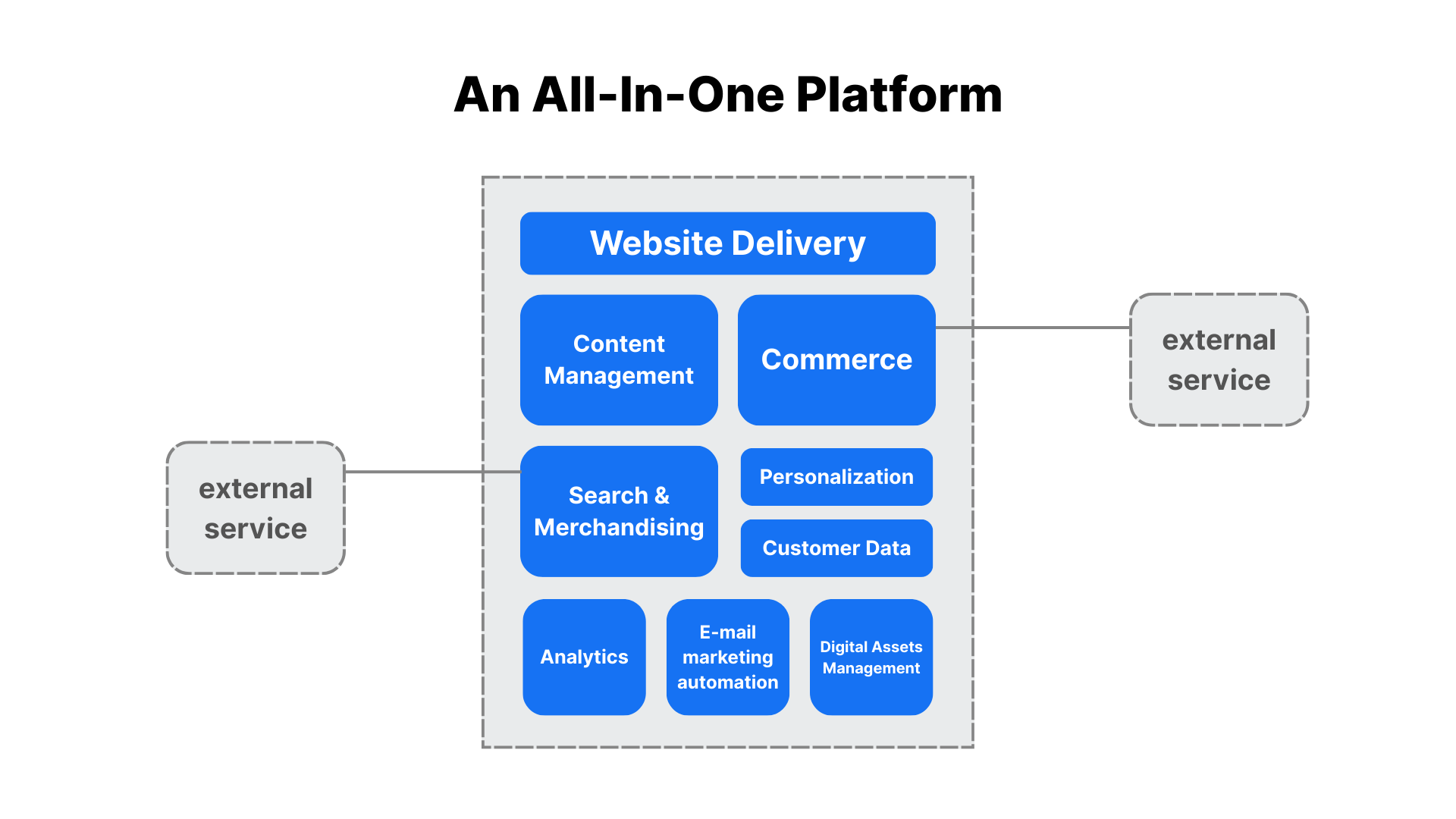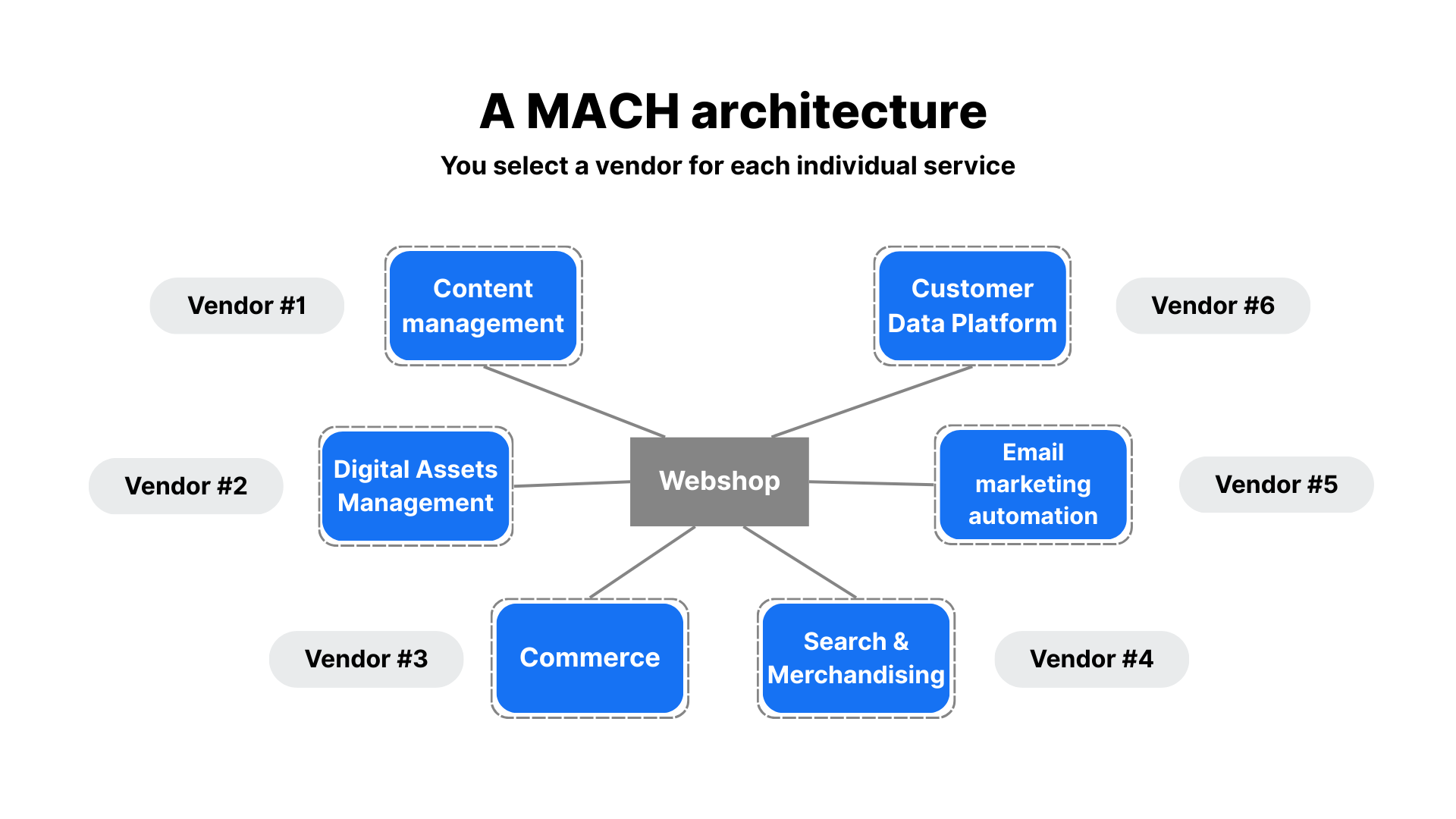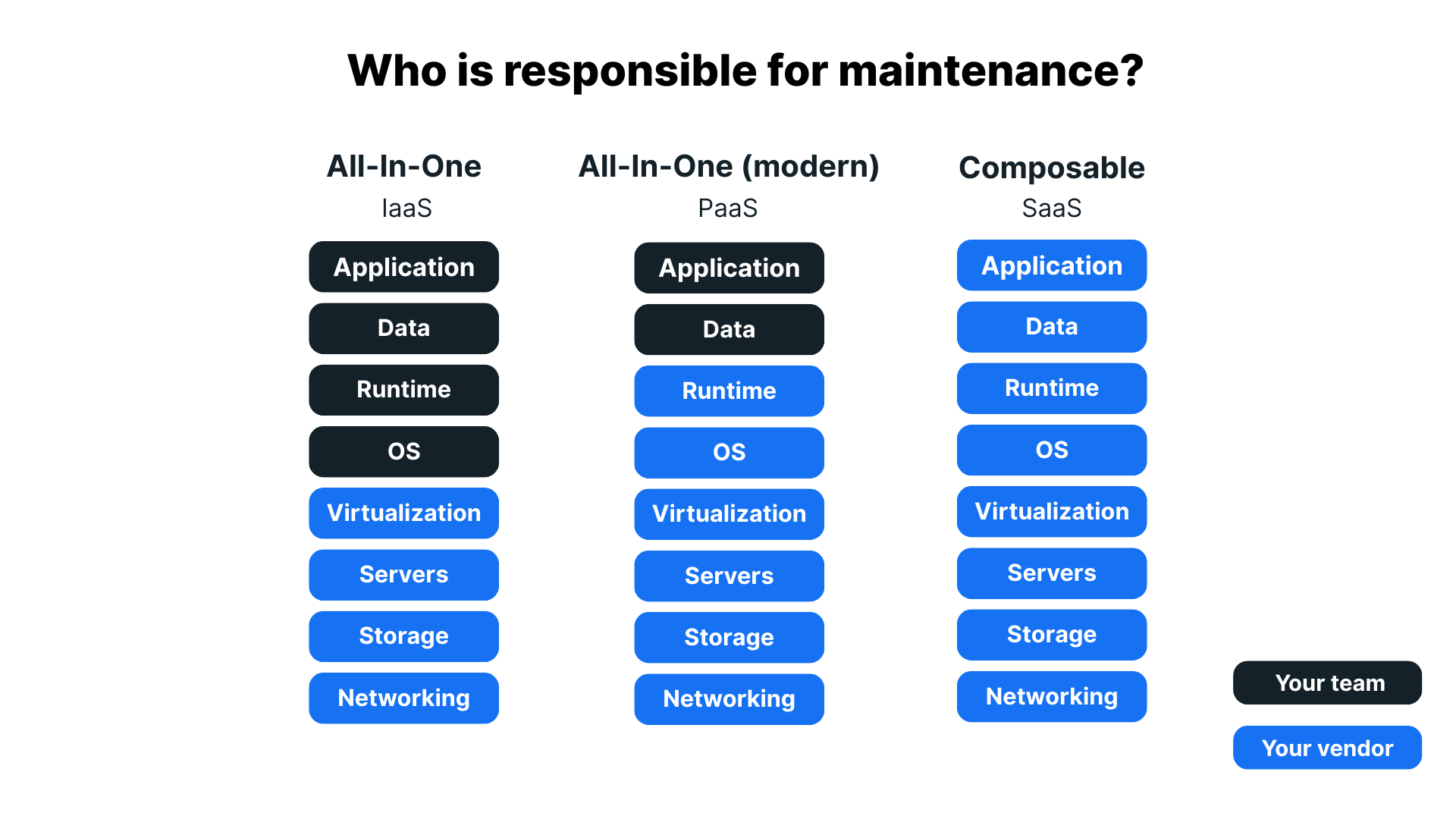
An All-In-One platform is provided by one supplier, but external services are often linked to it.

An All-In-One platform is provided by one supplier, but external services are often linked to it.
Every platform requires customization. This is unavoidable and takes a lot of time to develop and maintain. Developers must first create new code and then test everything to ensure it works properly. The difference between platforms lies in how the customization is implemented and why it's necessary. With All-In-One platforms, part of the platform is always managed by your supplier and part by your team. So you always share responsibility. Depending on your supplier, the structure of this division varies.
In the division of maintenance responsibilities, we generally recognize three categories that describe which services your supplier takes over:
The average All-In-One platform is IaaS, meaning that your team remains responsible for a lot of work. More modern All-In-One platforms address this more by switching to a PaaS system, but even then, responsibility remains with your own team. These three categories have further subdivisions, such as Managed PaaS, but for this explanation, we'll stick to the main categories.
Besides the fact that All-In-One platforms often place a lot of responsibility on your team, they also often make it more difficult for your team to create customized solutions. The latest All-In-One platforms can add additional (marketing) tools, such as a CRM or Marketing Automation service, thanks to APIs (Application Programming Interfaces). APIs are designed to easily extend and customize solutions. However, older All-In-One platforms often don't support these modern integrations. Moreover, All-In-One platforms aren't designed to work with tools outside of the complete packages. After all, an All-In-One provider's priority is to offer a single, robust, and complete package. If you do end up needing to integrate other tools, it often takes time because your team has to build and maintain a completely new integration.
The problem of spending too much time on maintenance and customization stems from the limitations of the technology. To solve this, you need to adapt the technology. An alternative that overcomes the limitations of an All-In-One platform is a Composable platform.
A Composable platform requires less maintenance because it's structured differently than an All-In-One platform. Instead of focusing on a complete package, it focuses on the connections between the services. This makes the architecture much more flexible and offers the possibility of combining individual, specialized services (also called "best-of-breed" solutions). This approach is known as a "MACH architecture," and it approaches the IaaS/PaaS and API components very differently: a MACH architecture is SaaS and API-first.

A Composable platform is built by combining services from different providers.
The image shows a few examples of these services. These don't necessarily have to be present.
A Composable platform is built entirely on SaaS services. These are services that are always offered via the cloud, and for which your provider is always fully responsible. In other words, your team doesn't have to maintain the service, and your daily processes can continue as normal. Because the platform runs entirely on these services, it frees up time that would otherwise have been spent on maintenance.
SaaS services offer another significant advantage: you can obtain detailed SLAs (Service Level Agreements). With SLAs, you can make agreements with your provider about various aspects of your platform, such as data storage, acceptable limits, and availability. This allows you to agree on acceptable downtime, for example. If you are unavailable, your provider may even have to compensate you. The key difference between SLAs on SaaS (Composable) and those of IaaS and PaaS (All-In-One) is that an SLA on a Composable platform can offer you more guarantees than an SLA on an All-In-One platform. An SLA on a Composable platform can guarantee speed. Because a Composable platform is a SaaS service, the service offered runs entirely on your provider's platform. This means your provider has full control over the service and can therefore offer more guarantees.
A Composable platform is truly designed to easily build custom solutions. Composable platforms are "API-first." This means they always support APIs. This makes the platform easy to extend and/or modify, so your team doesn't have to build integrations themselves. This saves a lot of time. Furthermore, the responsibility for maintaining the API doesn't fall on your team, allowing them to truly focus on building new features.

With an All-In-One platform, you're always partially responsible for maintenance.
This is in contrast to a Composable platform, where your supplier is fully responsible.
Besides saving significant time on maintenance, Composable platforms offer even more significant advantages. Their API-first approach allows you to easily update or replace components independently. Need to update your front-end? You can do that without impacting your back-end. Adding a new payment provider? No problem, without impacting other services.
This flexibility makes maintenance more predictable and less invasive. Instead of having to update the entire system, you can work on individual components. This reduces the complexity of the work and makes it easier to estimate the time investment for maintenance. Because estimation is easier, fewer unexpected problems arise, and your team can focus their energy on developing new features and improvements.
Composable Commerce solutions are characterized by speed. You benefit from this speed in two ways: you can quickly add new technologies, and the technologies themselves accelerate your workflows.
With a Composable Commerce platform, you can easily adopt new technologies. Think of AI-driven personalization, new omnichannel experiences, or innovative loyalty programs. Because the architecture is built on connectable services, you can easily add new technology to your existing setup without major rebuilding projects.
So you can quickly add new services, but you can also react quickly. Rapid responses to competition are essential in e-commerce. For example, if a competitor drops prices, you need to be able to quickly adjust the prices in your own catalog, or your customers will go to your competitor. A Composable platform is built so that your new prices can be adjusted quickly, ensuring you always remain relevant.
In short: your platform grows with your ambitions, instead of hindering your innovation.
Teams working with an All-In-One platform spend a lot of time on maintenance because they are responsible for it themselves. Moreover, this adds an extra layer of complexity, as all integrations with external suppliers often have to be created and maintained independently.
This problem arises from the technical limitations of the existing platform and can therefore be solved by switching to a new, differently structured platform. A Composable platform offers a solution: the SaaS services remove the responsibility for maintenance from your team, and they no longer have to build and maintain integrations themselves. This flexible MACH architecture frees your developers from endless maintenance and gives you the freedom to truly focus on innovation.
At Aviva Solutions, we help companies find the most suitable solutions. We combine our experience in complex e-commerce environments with a smart, results-driven approach. Together, we ensure your IT landscape supports your plans and you can get the most out of your platform.
Want to know how your organization can take the step to avoid constant maintenance? Feel free to contact us. We'd be happy to discuss your needs.